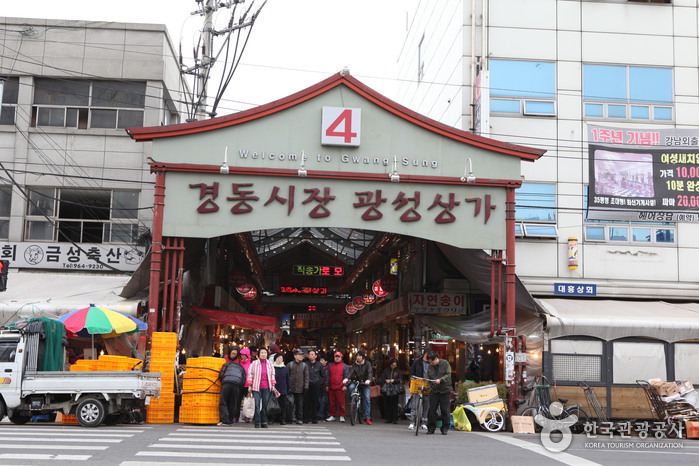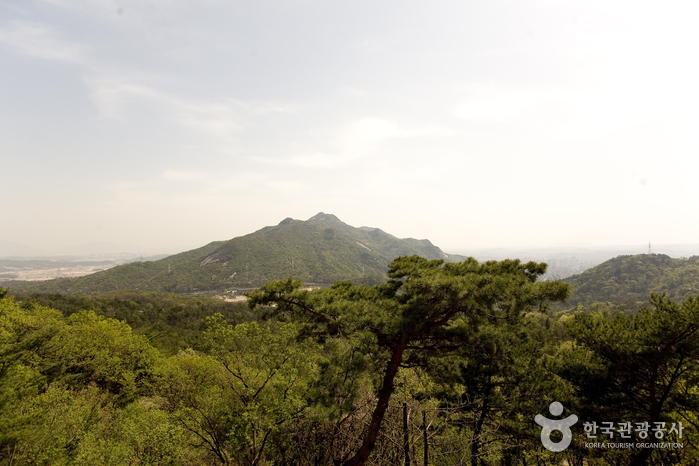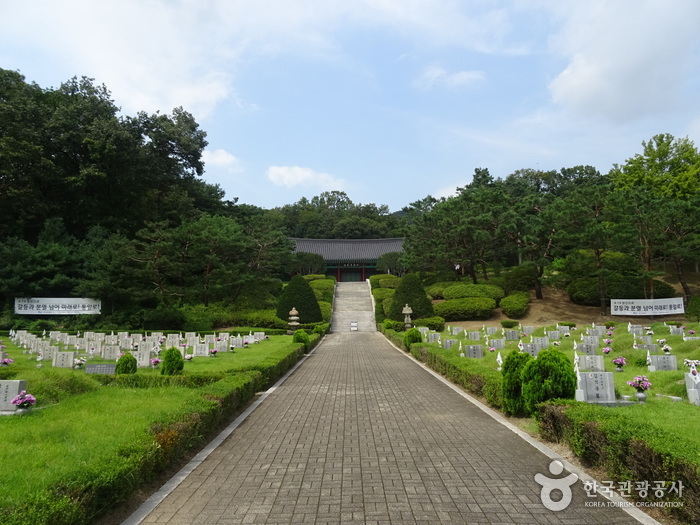Aritaum - Guri Doldari Sageori Branch [Tax Refund Shop] (아리따움 구리돌다리사거리)
6.2Km 0 2024-04-18
1F, 212, Gyeongchun-ro, Guri-si, Gyeonggi-do
-
Innisfree - Seongbuk Jeongneung Branch [Tax Refund Shop] (이니스프리 성북정릉)
6.3Km 0 2024-04-18
104, 40-3, Bogungmun-ro, Seongbuk-gu, Seoul
-
Olive Young - Jeongneung Branch [Tax Refund Shop] (올리브영 정릉)
6.3Km 0 2024-04-17
38, Bogungmun-ro, Seongbuk-gu, Seoul
-
Seoul Gyeongdong Market (서울 경동시장)
6.3Km 56565 2020-05-07
147, Wangsan-ro, Dongdaemun-gu, Seoul
+82-2-967-8721
As the nation began to recover from the aftermath of the Korean War, farmers from the northern Gyeonggi-do region and Ganwon-do gathered around the old Seongdong Station (renamed ‘Hansol Donguibogam’) to sell their produce and wares. The farmers’ impromptu gathering on the fallow farmland to make their transactions soon led to the birth of a new marketplace.
Gyeongdong Market is located around Jegi-dong, Yongdu-dong and Jeonnong-dong at Dongdaemun-gu and consists of the Gyeongdong Oriental Medicine Market, the Gyeongdong New Market, the Gyeongdong Old Market, the Gyeongdong Building, Hansol Donguibogam, and more.
Currently, renovations are underway to reinvent the out-dated market environment into an updated shopping experience that still preserves the area’s innate charm. In 2004, Hansol Donguibogam was built and opened on the spot where the Midopa Department Store used to stand. Hanbang Cheonha, Donguibogam Tower-Tel and other areas are now undergoing renovations.
Seoul Yangnyeongsi Market (서울 약령시장)
6.4Km 49201 2021-06-09
10, Yangnyeongjungang-ro, Dongdaemun-gu, Seoul
+82-2-969-4793
"Yangnyeongsi," which literally means medicine city district, refers to a central Oriental medicine district formed near major cities where medicinal herbs are collected and produced. Yangneongsi were first established by royal order during the Joseon dynasty for the purpose of effective production, distribution and management of medicinal products and herbs.
Seoul Yangnyeongsi Market history is relatively short, having formed naturally in the mid-1960s by medicinal herb merchants who gathered here seeking to sell their products with the city bus terminal and Cheongnyangni Station as their central base. Originally, these merchants came to Seoul through the old Seongdong Station and Chyeongnyangni Station after the Korean War, seeking to sell medicinal herbs and vegetation products that were cultivated and collected in the Gyeonggi-do and Gwangwon-do regions. This small market that was once open on an empty plot of land was later authorized as an official market establishment. Road and railroad developments between Gangwon-do and Seoul were followed and by the 1970s, the market grew into what is now seen today. The name Seoul Yangnyeongsi Market was given by the Seoul mayor in 1995.
Olive Young - Donam Jungang Branch [Tax Refund Shop] (올리브영 돈암중앙점)
6.4Km 0 2024-06-26
1F, 118, Dongsomun-ro, Seongbuk-gu, Seoul
-
Artbox - Guri Branch [Tax Refund Shop] (아트박스 구리)
6.4Km 0 2024-04-19
A section and 2F, 247, Gyeongchun-ro, Guri-si, Gyeonggi-do
-
Olive Young - Guri Station Branch [Tax Refund Shop] (올리브영 구리역)
6.4Km 0 2024-04-18
247, Gyeongchun-ro, Guri-si, Gyeonggi-do
-
Suraksan Mountain (수락산)
6.5Km 99207 2021-06-01
San 1-1, Sanggye-dong, Nowon-gu, Seoul
+82-2-2116-3943
Along with the other great mountains near Seoul, Suraksan Mountain has its own unique beauty throughout the year. Its cluster of small peaks is reminiscent of Seoraksan or Wolchulsan Mountains and among its valleys and peaks, a number of treasures unfold. These include Geunnyu, Eunnyu, and Ongnyu Waterfalls, Heungguksa, Naewonsa and Seongnimsa Temples, and Gwesanjeong Pavilion.
One of the most popular hiking courses on Suraksan Mountain is the one that starts from Danggogae Station (Seoul Subway Line 4) and passes Hangnimsa Temple and Yongguram Hermitage. In the springtime, the ridge between Suraksan Mountain and Buramsan Mountain is covered with gorgeous royal azalea blossoms.
April 19th National Cemetery (국립4.19민주묘지)
6.5Km 11055 2023-01-02
17, 4.19-ro 8-gil, Gangbuk-gu, Seoul
+82-2-996-0419
Located at the foot of Bukhansan Mountain, the April 19th National Cemetery was established in memory of the 224 people who lost their lives during the 4.19 Revolution in 1960. The cemetery features a memorial hall and a traditional wooden structure that houses the grave of the historic figure Yu Yeongbong.
At the cemetery is a pond surrounded by sculptures such as "Symbolic Door," "Roots of Democracy," and "Sparks of Justice" and a memorial tower bearing an inscription for the brave patriots who lost their lives during the revolution. Groves of pine, juniper, yew, and maple trees and the well-kept hiking path add a natural charm to the overwhelming ambiance of peace and serenity. Many people visit to see the spring blossoms in May, and throughout the year to take in the glorious scene of the sunset over Bukhansan Mountain.
![Aritaum - Guri Doldari Sageori Branch [Tax Refund Shop] (아리따움 구리돌다리사거리)](http://tong.visitkorea.or.kr/cms/resource/59/2889259_image2_1.jpg)


![Olive Young - Guri Station Branch [Tax Refund Shop] (올리브영 구리역)](http://tong.visitkorea.or.kr/cms/resource/63/2888663_image2_1.jpg)


 English
English
 한국어
한국어 日本語
日本語 中文(简体)
中文(简体) Deutsch
Deutsch Français
Français Español
Español Русский
Русский